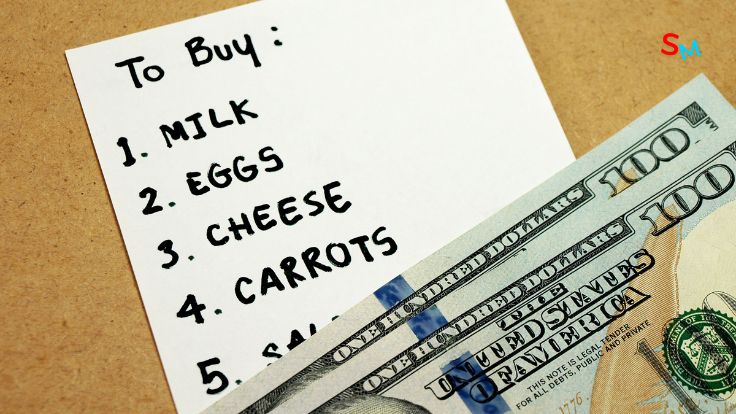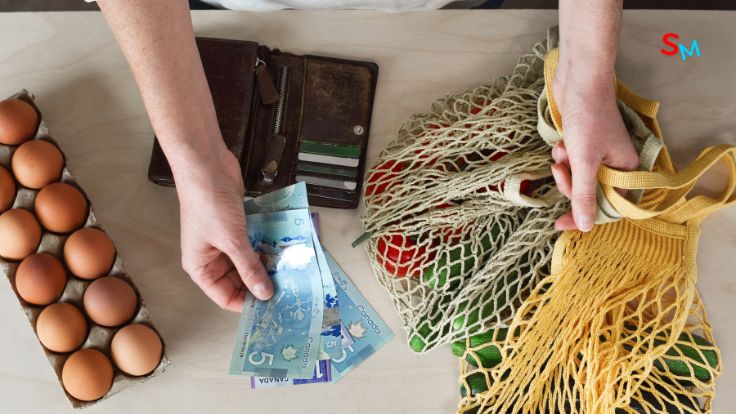Do you hate spending all your money at the grocery store? Well, you’re in luck! Today, I’m sharing my best tips on how to grocery shop on a budget. Trust me, it’s something you should definitely be doing. You’ll learn how to find the best prices and cheapest products. By the end, you’ll feel like a champion at saving money!
People often ask how to grocery shop on a budget, they wonder how can you make healthy meals for a big family while sticking to a tight budget. Well, I’ve got good news! In this article, I’ll be sharing all the answers. We’ll explore the world of budget grocery shopping together. And that’s not all! I’ve also got more grocery shopping tips and tricks for you. So, read the article and get ready to learn how you can save up to 50% on your grocery bill. It’s going to be awesome! see How to Eat Healthy on a Budget.
Contents
- 1 1. Create a budget
- 2 2. Make a meal plan
- 3 3. Check store flyers
- 4 4. Make a shopping list
- 5 5. Shop with cash
- 6 6. Use loyalty programs
- 7 7. Buy in bulk
- 8 8. Compare unit prices
- 9 9. Shop at discount stores
- 10 10. Shop seasonal produce
- 11 11. Avoid pre-packaged and processed foods
- 12 12. Don’t shop when hungry
- 13 13. Use coupons strategically
- 14 14. Shop at farmers’ markets
- 15 15. Shop towards the end of the day
- 16 16. Avoid single-serve items
- 17 17. Skip the convenience foods
- 18 18. Check the clearance section
- 19 19. Avoid bottled water
- 20 20. Use leftovers wisely
- 21 Conclusion
1. Create a budget

Creating a budget is my first tip for you on how to grocery shop on a budget. You start by listing your monthly income and expenses. Set a realistic spending limit for groceries based on your financial situation. Before shopping, make a meal plan and create a shopping list to avoid impulse buys. Look for sales, discounts, and coupons to save money. Compare prices at different stores and consider buying store brands, which are often cheaper. Avoid shopping when hungry to prevent unnecessary purchases. Stick to your budget and prioritize essential items. With careful planning and discipline, you can shop smartly and save money on groceries.
2. Make a meal plan
Start by deciding what meals you’ll have for the week. Consider using ingredients you already have to minimize waste. Plan meals that are easy and affordable, like pasta with vegetables or rice with beans. Make a shopping list based on the ingredients needed for your meals. Stick to the list while shopping to avoid unnecessary purchases. By having a meal plan, you’ll know exactly what to buy, reduce food waste, and prevent overspending. Plus, it’ll save you time and energy figuring out what to cook each day!
3. Check store flyers

Before heading to the store, take a look at the weekly flyers from different stores. These flyers contain special deals and discounts on various products. Look for items you frequently use or need at a lower price. For example, if you see that your favourite brand of cereal is on sale, you can plan to buy it during your shopping trip. By taking advantage of these sales, you can save money on your groceries and get more value for your budget. Remember to compare prices and make informed choices to maximize your savings.
4. Make a shopping list
Making a shopping list is vital before heading to the store. write down the items you need to buy. Consider planning your meals for the week to determine the ingredients you’ll require. Having a list keeps you focused and helps you avoid impulse purchases. If you need milk, bread, and eggs, write them down. Stick to your list while shopping and resist the temptation to add unnecessary items to your cart. This way, you can stay on track, save money, and ensure you only purchase what you genuinely need.
5. Shop with cash

Shopping with cash is another underrated and powerful technique for grocery shopping on a budget. Before going to the store, determine how much you can afford to spend. Withdraw that amount in cash and leave your cards at home. By using cash, you’re more aware of your spending and less likely to overspend. For instance, if your budget is $50, bring only that amount. As you shop, keep track of the prices and make choices accordingly. When the cash runs out, you know it’s time to stop. This method helps you stick to your budget, avoid unnecessary purchases, and stay in control of your expenses.
6. Use loyalty programs
Using loyalty programs is a fantastic way to grocery shop on a budget. Many stores offer loyalty programs where you can earn points or discounts on your purchases. Sign up for these programs to take advantage of the benefits. For example, if you buy groceries regularly from a specific store, enroll in their loyalty program. Scan your card or provide your phone number during checkout to accumulate points. These points can be redeemed for discounts or even free items in the future. By utilizing loyalty programs, you can save money on groceries and maximize your budget while enjoying the perks of being a loyal customer.
7. Buy in bulk

Purchasing items in larger quantities can often result in significant savings. That is to say, instead of buying individual cans of beans, opt for a larger bag or case. The unit price is typically lower, which means more value for your money. However, it’s crucial to consider perishable items and your storage capacity. Stock up on non-perishable goods like rice, pasta, or canned goods that have a longer shelf life. By buying in bulk, you can reduce your grocery expenses and have a well-stocked pantry for future meals.
8. Compare unit prices
Unit prices help you understand the cost per unit or ounce of a product, allowing you to make informed decisions. When shopping, look at the price per unit displayed on the shelf labels or packaging. For instance, if you’re buying pasta, compare the price per ounce between different brands and package sizes. Sometimes, buying a larger package might be more cost-effective than smaller ones. By comparing unit prices, you can identify the best deals and choose the most economical options, ultimately stretching your budget and getting the most value for your money.
9. Shop at discount stores

Instead of going to a high-end supermarket, consider visiting a nearby discount store. These stores offer products at lower prices compared to traditional supermarkets. Look for discount grocery stores or local markets in your area. They often carry similar products at more affordable rates. While the packaging might differ, the quality can still be good. By shopping at discount stores, you can save a significant amount on your grocery bill, making your budget go further and allowing you to meet your needs without overspending.
10. Shop seasonal produce
Shopping for seasonal produce is a smart strategy to grocery shop on a budget. Seasonal fruits and vegetables are abundant and more affordable during their peak harvest time. For instance, in the summer, you’ll find fresh and reasonably priced berries like strawberries or cherries. Similarly, during the fall, apples and pumpkins are often plentiful and economical. By choosing seasonal produce, you not only enjoy better taste and quality but also save money. Check local farmer’s markets or grocery store flyers to know what’s in season. Embracing seasonal produce allows you to diversify your meals, support local farmers, and keep your grocery expenses in check.
11. Avoid pre-packaged and processed foods

Avoiding pre-packaged and processed foods are often more expensive compared to fresh ingredients and can quickly consume your budget. So, instead of buying pre-cut fruit cups, purchase whole fruits and cut them yourself. Similarly, instead of purchasing frozen dinners, opt for ingredients to cook a homemade meal. By choosing fresh, unprocessed items, you not only save money but also prioritize your health. Plus, you have more control over the ingredients and can create delicious, nutritious meals at a fraction of the cost of pre-packaged alternatives.
12. Don’t shop when hungry
Do yo know that when we’re hungry, we tend to make impulsive and unnecessary purchases, which can quickly inflate our grocery bill? For instance, imagine going to the store on an empty stomach and grabbing extra snacks, sweets, or convenience foods that you don’t actually need. To prevent this, have a satisfying meal or snack before heading to the store. This way, you can shop with a clear mind and stick to your budget, focusing on the essential items on your list. Shopping when full helps you make rational decisions and saves you from impulse spending.
13. Use coupons strategically

Look for coupons in newspapers, online, or through store loyalty programs. However, it’s important to be selective and use them wisely. If you have a coupon for a product you regularly use, take advantage of the discount. On the other hand, avoid using coupons just because they’re available if the item isn’t necessary. Be mindful of expiration dates and combine coupons with store sales for even more savings. By using coupons strategically, you can reduce your grocery expenses and stretch your budget further without compromising on the items you need.
14. Shop at farmers’ markets
Farmer’s markets offer fresh, locally sourced produce at competitive prices. For example, instead of buying imported strawberries at a supermarket, visit a farmers market where you can find locally grown strawberries at a lower cost. Additionally, farmers’ markets often have a wide variety of fruits, vegetables, and other products at reasonable prices. You can directly support local farmers and artisans while enjoying affordable and high-quality goods. By shopping at farmers’ markets, you can save money, embrace seasonal produce, and have a more sustainable and budget-friendly grocery shopping experience.
15. Shop towards the end of the day

Many stores mark down prices on items nearing their expiration date or approaching the end of the day. For example, if you go to the grocery store in the evening, you may find discounts on bakery items, produce, or prepared meals that need to be sold quickly. By taking advantage of these discounted items, you can save money while still getting quality products. However, be mindful of freshness and food safety. Shopping towards the end of the day allows you to score great deals and stretch your budget further.
16. Avoid single-serve items
Avoiding single-serve items is a smart approach to grocery shopping on a budget. Individual or single-serve items tend to be more expensive compared to larger quantities or bulk options. For instance, instead of buying single-serve yoghurt cups, opt for a larger tub or container. By portioning it out yourself, you can save money in the long run. Similarly, instead of purchasing individually packaged snacks, consider buying a larger bag and portioning them into reusable containers. By avoiding single-serve items, you reduce packaging waste and stretch your budget by choosing more cost-effective options. Embrace larger sizes and portion control to save money without sacrificing convenience.
17. Skip the convenience foods

Skipping the convenience foods is a wise thing to do when you want to grocery shop on a budget. Convenience foods like pre-packaged meals, frozen dinners, or ready-to-eat snacks tend to be more expensive compared to cooking from scratch. For example, instead of buying a pre-made pizza, consider buying the ingredients to make your own pizza at home. By preparing meals yourself, you can save money and have more control over the ingredients. Additionally, cooking from scratch often leads to healthier and more satisfying meals. Invest some time in meal planning and preparation to avoid the extra cost of convenience foods and make the most of your budget.
18. Check the clearance section
Many stores have a dedicated area where they place discounted items nearing their expiration date or those with damaged packaging. You might find discounted canned goods, snacks, or pantry staples. By carefully examining the clearance section, you can score great deals on quality products. Just ensure to check the expiration dates and inspect the condition of the items. This way, you can save money while still getting items that are perfectly fine to consume. Shopping the clearance section helps you make the most of your budget and find hidden gems at a fraction of the original price.
19. Avoid bottled water

By avoiding bottled water, you can quench your thirst without draining your budget and make a positive impact on both your finances and the planet. So, instead of buying individual bottles of water, opt for reusable water bottles and refill them from the tap or invest in a water filter if needed. Switching from buying a pack of bottled water every week to a reusable bottle can save you a significant amount of money over time. It’s not only cost-effective but also environmentally friendly, reducing plastic waste.
20. Use leftovers wisely
Instead of letting leftover food go to waste, repurpose it into new meals. If you have leftover roasted chicken, you can shred it and use it as a filling for tacos or sandwiches the next day. By getting creative with leftovers, you not only minimize food waste but also stretch your grocery budget. Plan your meals around using up leftovers to maximize their potential. This way, you save money and enjoy delicious meals without having to buy additional ingredients.
Conclusion
Starting to eat healthy on a budget can be tough, just like starting a healthy diet. It may seem expensive at first because you have to learn how to cook and buy the right foods. But don’t worry, it gets easier with practice. Once you’ve learned these skills, you can save lots of money each month, maybe even thousands of dollars in the long run. Plus, by eating healthy, you can prevent health problems like diabetes or strokes, which could cost you even more money and harm your well-being. So, don’t be discouraged by the initial challenges; the benefits are worth it!
Leave a Reply